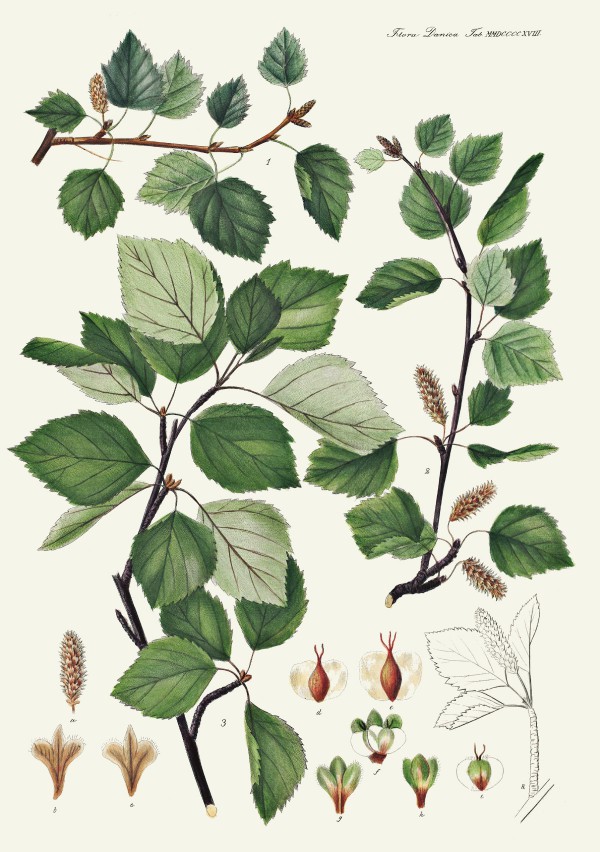Dies ist eine alte Version des Dokuments!
Betula pubescens Ehrh. - Betulaceae - downy birch, moor birch, Moor-Birke
Betula pubescens subsp. pubescens - syn. Betula alba L. - white birch
Betula pubescens subsp. tortuosa - syn. Betula tortuosa Ledeb. - mountain birch
Deciduous tree, up to 20m tall, native to North Europe and West Asia.
Fresh birch leaves own a very pleasant „green“ smell. Analyses showed that (Z)-3-hex-en-1-ol and 1-hexanol are major constituents of the birch-leaf volatiles from both B.pubescens (27%) and B.pendula (19%). Other compounds present are (E)-2-hexenal, (E)-β-ocimene, hexyl acetate, (E)-2-hexen-1-ol, and (E)-α-farnesene.
[Volatiles from nonhost birch trees inhibit pheromone response in spruce bark beetles. Byers, J. A., Zhang, Q. H., Schlyter, F., Birgersson, G., Naturwissenschaften, Vol.85(11), 1998, 557-561]
http://www.chemical-ecology.net/pdf/Byersetal1998.pdf
Main headspace volatiles collected in situ from leaf-bearing branches of B.pubescens were (ng/g dry leaf matter): (Z)-3-hexenol (62-202), (Z)-3-hexenyl acetate (26-501), α-pinene (1-186), β-pinene (1-102), sabinene (11-1250), (E)-β-ocimene (114), α-copaene (11-153), β-caryophyllene (174-496), caryophyllene oxide (98-184), and some unidentified sesquiterpenes. Other compounds found included eg. hexanol, nonanal, hexyl acetate, (E)-2-hexenyl acetate, (Z)-3-hexenyl butanoate, 3-carene, p-cymene, several unidentified sesquiterpenes, (E)-α-farnesene, linalool, methyl salicylate, and jasmone.
[Zhang, Qing-He, et al. „Leaf volatiles from nonhost deciduous trees: variation by tree species, season and temperature, and electrophysiological activity in Ips typographus.“ Journal of Chemical Ecology 25.8 (1999): 1923-1943]
The rectified oil of birch bark tar is used in perfumery for smoky-leathery-phenolic notes. The tar is manufactured by controlled heating of bark of various birch species (mainly white birch). Several methyl- and methoxy-substituted phenols and some naphtalene derivatives are found in the headspace of the tar (which is used in ancient times as adhesive for hafting lithic tools on wooden shaft or for repairing and decorating ceramic vessels). Volatile components of the liquid tar include phenol and derivatives like 2-methylphenol, 2-methoxyphenol (guaiacol), dimethoxyphenol, dimethylphenol, trimethylphenol, 2-methoxy-4-methylphenol, 4-ethyl-2-methoxyphenol e.g.; naphtalenes like methylnaphtalene, ethylnaphtalene, and trimethylnaphtalene, and sesquiterpenes like calamenene.
[Molecular characterisation of birch bark tar by headspace solid-phase microextraction gas chromatography-mass spectrometry: A new way for identifying archaeological glues., Regert, M., Alexandre, V., Thomas, N., Lattuati-Derieux, A., Journal of Chromatography A, 1101(1), 2006, 245-253]
The main components of the essential oil from the buds of B. pubescens ssp. pubescens and B.pubescens ssp. czerepanovii were caryophyllene derivatives like 14-acetoxy-β-caryophyllene (30.0-32.5%), birkenal (10.8-11.7%), and 6-hydroxycaryophyllene (11.7-15.1%).
[Başer, K. Hüsnü Can, and Betül Demirci. „Studies on Betula essential oils.“ Arkivoc 7.355 (2007): 348] http://www.arkat-usa.org/get-file.php?fileid=19883

Betula pubescens Ehrh. var. tortuosa as Betula odorata Bechst. var. tortuosa
Flora Danica [G.C. Oeder et al], fasicle 49, t. 2918 (1761-1883)
http://botanicalillustrations.org/species.php?id_species=141340
Betula pubescens
© Rolf Marschner (2007),
www.botanische-spaziergaenge.at
